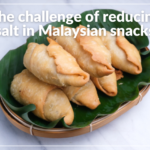Salt is a component that ignites a debate between consumers and the food industry. These days, the keyword is “reduction”, as seen in the increase of products on sale with a salt related claim (low/no/reduced sodium): up by 29% between 2014 and 2018 (1). All food categories are concerned, but mainly the snacks, seasonings, and ready meals. Let’s see how yeast extracts can help formulators to reduce salt while preserving the taste of their products.
Fact: too much salt in our food
The official recommendation of the World Health Organization (WHO) states that the daily salt intake should be around 5g for an adult (the equivalent of a teaspoon). In reality, the average per day and per person is between 9g and 12g, almost twice (2)! An excessive sodium consumption can lead to higher risks of developing cardiovascular diseases such as hypertension.
Initiatives for salt reduction have been addressed locally such as:
- Salt awareness week in the UK every year since 2008.
- Plan to lower the amount of salt in manufactured food items by the Chinese government in 2017.
- Public wellness promotion programs in Singapore: symbols on packaging and focus on out-of-home catering since 2009.
- National nutrition and health plan in France aiming to help population improving their diet with a focus on salt consumption. “Nutriscore” symbols have been on packaging since 2017.
As a result, food industries face a major challenge: offer salt reduced products with an appealing taste.
Yeast extracts, the ideal ally for salt reduction
Biospringer successfully supports manufacturers in addressing the worldwide movement for salt reduction by offering a wide range of yeast extracts that subtly reveal the flavor of their products while allowing for a significant salt reduction.
In short, yeast extract is a natural flavoring ingredient that works just like spices. When added to a recipe, it brings out taste and boosts flavors. There are different types of yeast extracts and each one has a specific influence on taste:
- Contributes to umami flavor: this flavor is well known in Asian cuisine. It improves the overall taste of a product. This flavor is naturally found in foods such as tomatoes, mushrooms, or parmesan cheese. It is usually known as the “fifth taste” along with saltiness, sweetness, sourness, and bitterness. Umami has the particularity of bringing “mouthfulness” and long-lasting flavor. Due to its ability to increase the salty perception, it is a key tool for salt reduction.
- Brings taste and reveals notes: yeast extract is an incredible tool to build taste. It allows you to get subtle and savory taste profiles by bringing base-notes like bouillon, but also specific notes like meaty, cheesy, and vegetable flavor notes.
Working with yeast extracts can help food makers achieve up to 30% salt reduction in their food formulations without compromising taste. It is a success in many recipes such as Bolognese sauce, chicken bouillon, bacon flavored snacks, and vegan burgers.
Yeast extract is therefore a healthy and natural solution for salt reduction. At the consumer level, it can be compared to one of spices that consumers have in kitchen and that nutritionists recommend!
To get more insights,
Biospringer is a specialist of yeast extract. It is recognized worldwide as a historical key player and global producer. Its expertise through teams of technologists, flavorists, and expert tasting panels, ensures total safety and high quality of all the products manufactured and sold in the world. In addition, its global network of culinary centers is dedicated to finding technical solutions for its customers in order to bring good taste to their recipes in line with the current natural, vegan and vegetarian, and clean label food trends.
(1) Mintel, products launch between 2014 and 2018, with a low/no/reduced sodium as the claim, 2019
(2) WHO recommendations, salt reduction, 2016









